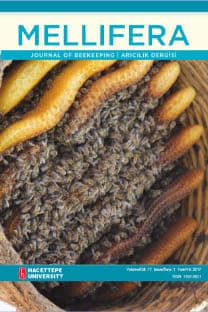Kastor çöplerinden (Hymenoptera, megachilidae) yuva yapan ve soliter bir arı türü olan megachile (Callomegachile) cephalotes Smith' in yuva biyolojisi
Bu çalışmada Megachile (Callomegachile) cephalotes Smith' in yuvalanma biyolojisi, yuva yeri, yuvanın yapısı ve başlangıç aşamaları dahil olmak üzere anlatılmaktadır. Dişi an, yalnızca çamur ve ağız salgıları kullanarak ve kastor çubuklarının boğum yerlerini çaprazlama yerleştirerek yuva adacıkları oluşturmaktadır. Akdarı samanlanyla birleştirilen bu çubuklar bir kulübenin tepesine yığılmaktadır. Grubun larva filojenisi üzerine yapılan kısa bir gözlem, bunların ikinci larval, son larva ve pupa dönemlerine ilişkin taksonomik tanımlara uyduğunu göstermektedir. Soliter arı türleri Hindistan'ın kuzeyinde ve ona kesimlerinde hayli yaygındır ve bu türe mensup arılar gerek ziraii gerekse yabani birçok bitkiyi sıkça dolaşmaktadır.
Nesting biology of megachile (Callomegachile) cephalotes Smith, a solitary bee that nests in castor sticks (Hymenoptera, megachilidae)
Nesting biology of Megachile (Callomegachile) cephalotes Smith is described including features of nesting site, nest structure and immature stages. The female constructed haphazardly overlapped nest chambers, over-crossing the node and internode region in vacated pith of castor sticks exclusively using gravel mud mixed with oral secretions. These sticks tied with straws of Pearl millet, were thatched on a hut. A brief larval phylogeny of the group follows the taxonomic descriptions of second instar, postdefecating larva and the pupa. The solitary bee species is quite widely distributed all over north and central India and significantly visits many cultivated and wild crops.
___
- 1. Gupta, R. K., Taxonomic studies on the Megachilidae of Northwestern India, Scientific Publishers, v + 294, 1993 (reprint 1999).
- 2. Gupta, R. K., Yadav, S., Apoidean species composition on Crotalaria juncea L., Cajanus cajan (L.), Helianthus annus L. and Brassica compestris L. var sar son Prain in eastern Rajasthan, India (Hymenoptera), Opuscula zoologica fluminensia, 198: 1-10, 2001.
- 3. Kapil, R. P., Grewal, G. S., Atwal, A. S., Biology and nesting behaviour of Megachile lanata Fabricius, 22nd International Beekeeping Congress, 1969: 449-458, 1970.
- 4. Gupta, R. K., Naval, R. K., Charan, S. K., Nesting biology of the solitary bee, Megachile (Pseudomegachile) creusa Smith (Insecta, Hymenoptera, Apoidea, Megachilidae), Mellifera, 3(5): 11-18 & 43-50, 2003.
- 5. Batra, S. W. T., Nests of Ceratina, Pithitis and Braunsapis from India (Hymenoptera: Anthophoridae), Oriental Insects, 10(1): 1-9, 1976.
- 6. Krombein, K. V., Trap nesting wasps and bees: life histories, nests and associates, Smithsonian Press, Washington D.C., vi + 570, 1967.
- 7. Rozen, J. G., Jr., Nesting biology of the bee Ashmeadiella holtii and its cleptoparasite, a new species of Stelis (Apoidea: Megachilidae), American Museum Novitates, 2900: 1-10, 1987.
- 8. Chaudhary, J. R., Jain, K. L., Nesting and foraging behaviour of a mason bee, Megachile lanata (Megachilidae: Hymenoptera), Indian Journal of Entomology, 40(4): 405-411,1978.
- 9. Malyshev, S. I., The nesting habits of solitary bees, A comparative study, EOS, (1935) 11: 201-309, 1936.
- 10. Romasenko, L. P., The nest architecture of some species of bees of the genus Megachile Latr. Apoidea, Megachilidae), Pp. 69-75. In: Fauna and biocenotic relationships of insects of the Ukraine.
- 11. Maxwell-Lefroy, H., Howlett, E. M., Indian Insect Life, hacker, Spink & Co. Calcutta & Simla. 786 pp., 1909.
- 12. Atwal. A. S., Insect pollinators of crops, Punjab Agricultural University Press, Ludhiana, 116 pp., 1970.
- 13. Cane, J. H., Dufour's gland secretion in the cell linings of bees (Hymenoptera: Apoidea), Journal of Chemical Ecology, 7: 403-410, 1981.
- 14. Cane, J. H., Michener, C. D., Chemistry and function of mandibular gland products of bees of the genus Exoneura (Hymenoptera, Anthophoridae), Journal of Chemical Ecology, 9(12): 1525-1531, 1983.
- 15. Hefetz, A., Batra, S. W. T., Blum, M. S., Chemistry of the mandibular gland secretion of the Indian bee Pithitis smaragdula, Journal of Chemical Ecology, 5: 753-758, 1979.
- 16. Batra, S. W. T., Bees of India (Apoidea), their behaviour, management and a key to the genera, Oriental Insects, 11(3): 289-324, 1977.
- 17. Michener, C. D., The bees of the World, The John Hopkins University Press, Baltimore and London, xiv + 1-913 pp., 2000.
- 18. Krombein, K. V., Norden, B. B., Notes on the behaviour and taxonomy of Megachile (Xeromegachile) brimleyi Mitchell and its probable cleptoparasite, Celioxys galactiae Mitchell (Hymenoptera: Megachilidae), Proceedings of the Entomological Society of Washington, 97: 86-89, 1995.
- 19. Michener, C. D., Comparative morphological and systematic studies of bee larvae with a key to the families of Hymenopterous larvae, The University of Kansas Science Bulletin 35: 987-1102, 1953.
- 20. Michener, C. D., Observations on the pupae of bees, Pan-Pacific Entomologist, 30: 63-70, 1.954.
- 21. Eickwort, G. C, Matthews, R. W., Carpenter, J., Observations on the nesting behavior of Megachile rubi and M. texana with a discussion of the significance of soil nesting in the evolution of megachilid bees, Journal of the Kansas Entomological Society, 54(3): 557-570, 1981.
- 22. Cane, J. H., Carlson, R., Dufour's gland glycerides from Anthophora, Emphoropsis (Anthophoridae) and Megachile (Megachilidae) bees (Hymenoptera: Apoidea), Comparative Biochemistry and Physiology, 78 B: 769-772,1984.
- 23. Krombein, K. V., Norden, B. B., Notes on trap-nesting Sri Lankan wasps and bees (Hymenoptera: Vespidae, Pompilidae, Sphecidae, Colletidae and Megachilidae), Proceedings of the Entomological Society of Washington 103:274-281,2001.
- ISSN: 1302-5821
- Başlangıç: 2001
- Yayıncı: Hacettepe Üniversitesi
Sayıdaki Diğer Makaleler
Tüylü Aslı ÖZKÖK, Kadriye SORKUN
İç Anadolu Bölgesi bazı bombus arısı (Bombus, Apidae, Hymenoptera) türlerinde allozim çeşitliliği
Neşe ÇAĞATAY, A. Murat AYTEKİN
Propolisin suda çözünür bir türevinin fareler üzerindeki radyoaktif etkisi
Nada ORSOLİC, Zoran TADİC, Vesna BENKOVİÇ, Mirko LOJKİC, Ivan BASİC, Anica HORVAT
Raşiv K. GUPTA, Ravindra k. NAVAL, Santosh K. CHARAN, Abhishek RAJPUROHIT
